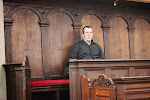 The Fiddle is the Devil's Instrument by Brett J. Talley
The Fiddle is the Devil's Instrument by Brett J. TalleyMy rating: 3 of 5 stars
It's difficult to write in another author's well established universe, in this case Lovecraft's Cthulhu mythos, and really stand out. To that end, this collection of stories both succeeds and occasionally fails.
First, it succeeds at the most essential level: its writing. The stories are all interesting and certainly draw you in. Talley's modern style could easily attract readers into the Cthulhu mythos who might find Lovecraft's original stories too archaic and his lengthy descriptions tedious or too difficult. To that end, these stories are much more accessible to modern readers than the original source material. The problem is this: as a teenager, I noticed that all of Lovecraft's characters either die or go mad and most modern Cthulhu stories continue this trend so that the stories become predictable. Talley is frequently guilty of this (as an author, I confess I am guilty of this as well), but when he strays from the formula, his stories stand out. Indeed, our first story, "The Fiddle is the Devil's Instrument," is a strong start to this collection. Talley creates a strong and eerie mood that captures the feel of Lovecraft nicely, but then takes a turn in a different direction. My only criticism here is that it didn't feel self-contained, instead it felt like the opening chapter to a novel and to that end, I would have enjoyed reading more. But leave them wanting more is an old showbiz adage and so I happily continued.
The second story, though not my favorite, stands out because it's so outlandishly different from anything else I've read in the genre. Our protagonist is a rodeo clown! Again, Talley creates an interesting situation, but this time he falls into the predictable pattern of most Lovecraftian horror. In fact, the dramatic sting of the story's ending relies on the reader being familiar with Cthulhuian mythology, but to anyone already familiar with it, the second half of the story will also feel all too familiar.
Our third story, "What the Dead Can Tell" is one of my favorites in the collection. Talley seems like he writes best when he escapes the standard conventions of Lovecraft and updates the mythos to our modern times (well, more modern anyway). I don't want to reveal too much, but this story takes place during the final days of the Cold War as special agent Crowley (no comment) interrogates a KGB agent about the strange satellite findings deep in the country's interior.
Even though "The Space Between Spaces" follows the traditional Lovecraftian formula almost to a fault, draping it modern science (it takes place at the Large Hadron Collider) somehow makes it more fun and for that reason I enjoyed it even though I knew exactly where it was going.
I don't wish to summarize each of the stories, so suffice to say that there's no doubt Talley can write well and pull you through his stories, but it's what he does within that structure that decides if they will stay with you or not. Unfortunately, he ends too many stories with either someone's last words or the dramatic sting of a final line. Sometimes it works, but other times it doesn't and in the case of "The Piper in Yellow" I thought it completely unnecessary as it erases any subtlety to an otherwise enjoyable story.
Despite these problems, this is nevertheless a collection of mostly satisfying stories that traipse through the dark shadows of cosmic horror and I would certainly recommend it to anyone who is a fan of the genre.
View all my reviews





No comments:
Post a Comment